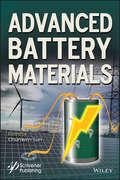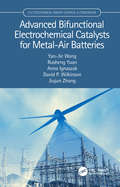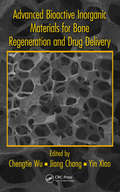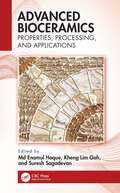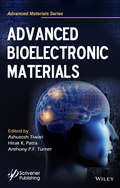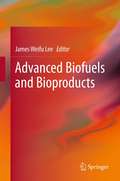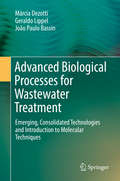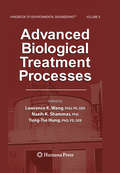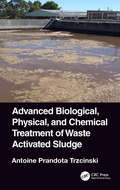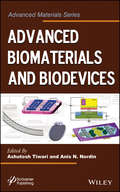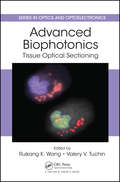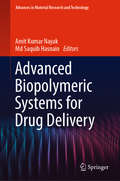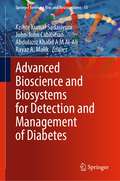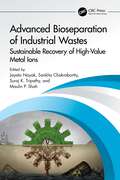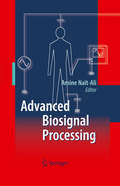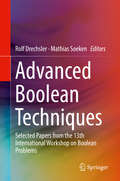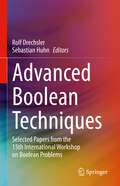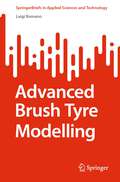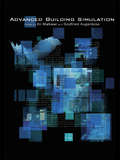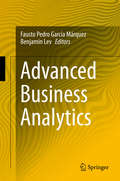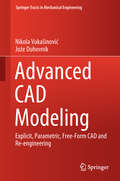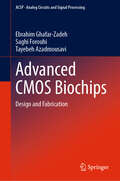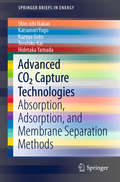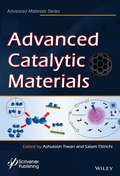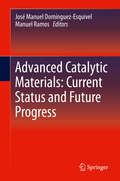- Table View
- List View
Advanced Battery Materials
by Chunwen SunElectrochemical energy storage has played important roles in energy storage technologies for portable electronics and electric vehicle applications. During the past thirty years, great progress has been made in research and development of various batteries, in term of energy density increase and cost reduction. However, the energy density has to be further increased to achieve long endurance time. In this book, recent research and development in advanced electrode materials for electrochemical energy storage devices are presented, including lithium ion batteries, lithium-sulfur batteries and metal-air batteries, sodium ion batteries and supercapacitors. The materials involve transition metal oxides, sulfides, Si-based material as well as graphene and graphene composites.
Advanced Bifunctional Electrochemical Catalysts for Metal-Air Batteries (Electrochemical Energy Storage and Conversion)
by Jiujun Zhang David P. Wilkinson Yan-Jie Wang Rusheng Yuan Anna IgnaszakMetal-air batteries (MABs) have attracted attention because of their high specific energy, low cost, and safety features. This book discusses science and technology including material selection, synthesis, characterization, and their applications in MABs. It comprehensively describes various composite bifunctional electrocatalysts, corrosion/oxidation of carbon-containing air cathode catalysts, and how improvements can be achieved in the catalytic activities of oxygen reduction reaction and oxygen evolution reaction and their durability/stability. This book also analyzes, compares, and discusses composite bifunctional electrocatalysts in the applications of MABs, matching the fast information of commercial MABs in requirements. Aimed at researchers and industry professionals, this comprehensive work provides readers with an appreciation for what bifunctional composite electrocatalysts are capable of, how this field has grown in the past decades, and how bifunctional composite electrocatalysts can significantly improve the performance of MABs. It also offers suggestions for future research directions to overcome technical challenges and further facilitate research and development in this important area.
Advanced Bioactive Inorganic Materials for Bone Regeneration and Drug Delivery
by Chengtie Wu Jiang Chang Yin XiaoBioceramics play an important role in repairing and regenerating defective or damaged bone. This volume reviews the latest advances in the field. Offering guidance for biomedical engineering researchers and material scientists, the book summarizes innovative concepts, bioceramic design, and methods for material synthesis and drug delivery. It covers design and fabrication of these materials, down to the nanoscale, and includes chapters on medical device engineering using these materials. The book is designed to enhance study and career development for those in this field and to facilitate further research and opportunities for new solutions.
Advanced Bioceramics: Properties, Processing, and Applications
by Kheng Lim Goh Md Enamul Hoque Suresh SagadevanAdvanced Bioceramics: Properties, Processing, and Applications describes development of bioceramics and biocomposites, which are used in various biomedical applications including bone tissue repair, remodelling and regeneration. It covers the fundamental aspects of materials science and bioengineering, clinical performance in a variety of applications, ISO/ASTM specifications, and opportunities and challenges. • Offers a comprehensive view of properties and processing of bioceramics. • Highlights applications in dentistry, orthopaedic and maxillofacial implants, and regenerative and tissue engineering. • Covers ISO/ASTM specifications such as processing, clinical applications, recycling/reuse and disposal standards. • Explores health, environmental and ethical issues. With contributions from eminent editors and recognized authors around the world, this book should serve as an important reference for academics, scientists, researchers, students and practitioners in materials science and biomedical engineering. It is to assist in the design of novel, targeted and personalised bioceramic-based solutions to advanced healthcare.
Advanced Bioelectronics Materials
by Ashutosh Tiwari Anthony P. Turner Hirak K. PatraThis book covers the recent advances in the development of bioelectronics systems and their potential application in future biomedical applications starting from system design to signal processing for physiological monitoring, to in situ biosensing. Advanced Bioelectronics Materialshas contributions from distinguished international scholars whose backgrounds mirror the multidisciplinary readership ranging from the biomedical sciences, biosensors and engineering communities with diverse backgrounds, interests and proficiency in academia and industry. The readers will benefit from the widespread coverage of the current literature, state-of-the-art overview of all facets of advanced bioelectronics materials ranging from real time monitoring, in situ diagnostics, in vivo imaging, image-guided therapeutics, biosensors, and translational biomedical devices and personalized monitoring.
Advanced Biofuels and Bioproducts
by James W. LeeDesigned as a text not only for students and researchers, but anyone interested in green technology, Advanced Biofuels and Bioproducts offers the reader a vast overview of the state-of-the-art in renewable energies. The typical chapter sets out to explain the fundamentals of a new technology as well as providing its context in the greater field. With contributions from nearly 100 leading researchers across the globe, the text serves as an important and timely look into this rapidly expanding field. The 40 chapters that comprise Advanced Biofuels and Bioproducts are handily organized into the following 8 sections: · Introduction and Brazil's biofuel success · Smokeless biomass pyrolysis for advanced biofuels production and global biochar carbon sequestration · Cellulosic Biofuels · Photobiological production of advanced biofuels with synthetic biology · Lipids-based biodiesels · Life-cycle energy and economics analysis · High-value algal products and biomethane · Electrofuels
Advanced Biological Processes for Wastewater Treatment: Emerging, Consolidated Technologies and Introduction to Molecular Techniques
by Márcia Dezotti Geraldo Lippel João Paulo BassinThis book presents recent developments in advanced biological treatment technologies that are attracting increasing attention or that have a high potential for large-scale application in the near future. It also explores the fundamental principles as well as the applicability of the engineered bioreactors in detail. It describes two of the emerging technologies: membrane bioreactors (MBR) and moving bed biofilm reactors (MBBR), both of which are finding increasing application worldwide thanks to their compactness and high efficiency. It also includes a chapter dedicated to aerobic granular sludge (AGS) technology, and discusses the main features and applications of this promising process, which can simultaneously remove organic matter, nitrogen and phosphorus and is considered a breakthrough in biological wastewater treatment. Given the importance of removing nitrogen compounds from wastewater, the latest advances in this area, including new processes for nitrogen removal (e. g. Anammox), are also reviewed. Developments in molecular biology techniques over the last twenty years provide insights into the complex microbial diversity found in biological treatment systems. The final chapter discusses these techniques in detail and presents the state-of-the-art in this field and the opportunities these techniques offer to improve process performance.
Advanced Biological Treatment Processes: Volume 9 (Handbook of Environmental Engineering #9)
by Lawrence K. Wang Yung-Tse Hung Nazih K. ShammasVolume 9: Advanced Biological Treatment Processes in the Handbook of Environmental Engineering series provides critical insight into pollution-abatement engineering. This outstanding collection of methodologies is designed as a review of engineering systems currently being used, as well as their potential for use in pollution abatement. The book's expert panel of authors provides a look at a range of topics, including principles and kinetics of biological processes, vertical shaft bioreactors, upflow sludge blanket filtration, membrane bioreactors, column bioreactor, SBR, nitrification, denitrification, and emerging biological processes. Volume 9: Advanced Biological Treatment Processes and its sister book - Volume 8: Biological Treatment Processes - are indispensable as both basic biological treatment textbooks and comprehensive reference books for advanced undergraduate and graduate students, designers of waste treatment systems, scientists, and researchers. A gold-standard addition to The Humana Press series, Volume 9: Advanced Biological Treatment Processes gives readers a cutting-edge illustration of the theory and practice of biological abatement systems and their critical role in environmental issues today.
Advanced Biological, Physical, and Chemical Treatment of Waste Activated Sludge
by Antoine Prandota TrzcinskiRecently, research efforts aiming to improve energy efficiency of wastewater treatment processes for large centralized wastewater treatment plants (WWTPs) have been increasing. Global warming impacts, energy sustainability, and biosolids generation are among several key drivers towards the establishment of energy-efficient WWTPs. WWTPs have been recognized as major contributors of greenhouse gas emissions as these are significant energy consumers in the industrialized world. The quantity of biosolids or excess waste activated sludge produced by WWTP will increase in the future due to population growth and this pose environmental concerns and solid waste disposal issues. Due to limited capacity of landfill sites, more stringent environmental legislation, and air pollution from incineration sites, there is a need to rethink the conventional way of dealing with wastewater and the sludge production that comes with it. This book provides an overview of advanced biological, physical and chemical treatment with the aim of reducing the volume of sewage sludge. Provides a comprehensive list of processes aiming at reducing the volume of sewage sludge and increasing biogas production from waste activated sludge. Includes clear process flowsheet showing how the process is modified compared to the conventional waste activated sludge process. Provides current technologies applied on full scale plant as well as methods still under investigation at laboratory scale. Offers data from pilot scale experience of these processes
Advanced Biomaterials and Biodevices (Advanced Material Series)
by Ashutosh Tiwari Anis N. NordinBiomaterials are the fastest-growing emerging field of biodevices. Design and development of biomaterials play a significant role in the diagnosis, treatment, and prevention of diseases. Recently, a variety of scaffolds/carriers have been evaluated for tissue regeneration, drug delivery, sensing and imaging. Liposomes and microspheres have been developed for sustained delivery. Several anti-cancer drugs have been successfully formulated using biomaterial. The targeting of drugs to certain physiological sites has emerged as a promising tool in the treatment with improved drug bioavailability and reduction of dosing frequency. Biodevices-based targeting of drugs may improve the therapeutic success by limiting the adverse drug effects and resulting in more patient compliance and attaining a higher adherence level. Advanced biodevices hold merit as a drug carrier with high carrier capacity, feasibility of incorporation of both hydrophilic and hydrophobic substances, high stability, as well as the feasibility of variable courses. Biodevices for diagnosis of diseases by improving the sensitivity and selectivity on the biomaterials platform is the most latest R & D focus especially in the field of treatment by the prognosis and detection of disease in the early stage. This groundbreaking book is devoted to all of the emerging areas of biomaterials and biodevices including therapeutic agents, molecular targeting and diagnostic imaging capabilities. The senior contributors write on the following topics:Frontiers for bulk nanostructured metalsStimuli-responsive materials used as medical devicesRecent advances with liposomes as drug carriersFabrication, Properties of nanoshells with controllable surface chargeAdvanced healthcare materials: ChitosanAnticipating behaviour of advanced material in healthcareLabel free biochipsPolymer MEMS sensorsAssembly of polymers/metal nanoparticlesCombination of molecular imprinting and nanotechnologyEfficiency of biosensors as new generation of analytical approachesState-of-the-art of biosensors in healthcare
Advanced Biophotonics: Tissue Optical Sectioning (Series in Optics and Optoelectronics)
by Valery V. Tuchin Ruikang K. WangDespite a number of books on biophotonics imaging for medical diagnostics and therapy, the field still lacks a comprehensive imaging book that describes state-of-the-art biophotonics imaging approaches intensively developed in recent years. Addressing this shortfall, Advanced Biophotonics: Tissue Optical Sectioning presents contemporary methods and
Advanced Biopolymeric Systems for Drug Delivery (Advances in Material Research and Technology #133)
by Amit Kumar Nayak Md Saquib HasnainThis book discusses the recent innovations in the development of various advanced biopolymeric systems, including gels, in situ gels, hydrogels, interpenetrating polymer networks (IPNs), polyelectrolyte complexes (PECs), graft co-polymers, stimuli-responsive polymers, polymeric nanoparticles, nanocomposites, polymeric micelles, dendrimers, liposomes and scaffolds. It also examines their applications in drug delivery.
Advanced Bioscience and Biosystems for Detection and Management of Diabetes (Springer Series on Bio- and Neurosystems #13)
by Kishor Kumar Sadasivuni John-John Cabibihan Rayaz A. Malik Abdulaziz Khalid A M Al-AliThis book covers the medical condition of diabetic patients, their early symptoms and methods conventionally used for diagnosing and monitoring diabetes. It describes various techniques and technologies used for diabetes detection. The content is built upon moving from regressive technology (invasive) and adapting new-age pain-free technologies (non-invasive), machine learning and artificial intelligence for diabetes monitoring and management. This book details all the popular technologies used in the health care and medical fields for diabetic patients. An entire chapter is dedicated to how the future of this field will be shaping up and the challenges remaining to be conquered. Finally, it shows artificial intelligence and predictions, which can be beneficial for the early detection, dose monitoring and surveillance for patients suffering from diabetes
Advanced Bioseparation of Industrial Wastes: Sustainable Recovery of High-Value Metal Ions
by Maulin P. Shah Sankha Chakrabortty Jayato Nayak Suraj K. TripathyAdvanced Bioseparation of Industrial Wastes: Sustainable Recovery of High-Value Metal Ions examines resource recovery from a variety of industrial waste streams, including sludge and wastewater, with an emphasis on both the fundamentals and the more advanced concepts involved. Chemical leaching, waste treatment, and other processes for metal extraction are broken down into their component parts in great detail. Several important metals, such as lithium, copper, gold, platinum, nickel, zinc, chromium, uranium, cobalt, rhodium, and indium, could be salvaged from recyclables. This book presents the best practices for dealing with waste from industries such as those involved in the production of electronic goods, automobiles, batteries, as well as mining and electroplating. It provides readers with a comprehensive understanding of the many forms of industrial waste, including their composition, recycling processes, and the potential for recovery of essential metals, from the ground up.Features: Provides updated occurrence and characteristics of a variety of high-value metal ions that can be recovered from different industrial wastes. Presents advanced chemical leaching technologies for those metal ions. Describes detailed accounts of physico-chemical-based reuse and recycle methodologies. Covers innovative approaches for the reutilization and management of industrial wastes.
Advanced Biosignal Processing
by Amine Nait-AliThrough 17 chapters, this book presents the principle of many advanced biosignal processing techniques. After an important chapter introducing the main biosignal properties as well as the most recent acquisition techniques, it highlights five specific parts which build the body of this book. Each part concerns one of the most intensively used biosignals in the clinical routine, namely the Electrocardiogram (ECG), the Elektroenzephalogram (EEG), the Electromyogram (EMG) and the Evoked Potential (EP). In addition, each part gathers a certain number of chapters related to analysis, detection, classification, source separation and feature extraction. These aspects are explored by means of various advanced signal processing approaches, namely wavelets, Empirical Modal Decomposition, Neural networks, Markov models, Metaheuristics as well as hybrid approaches including wavelet networks, and neuro-fuzzy networks. The last part, concerns the Multimodal Biosignal processing, in which we present two different chapters related to the biomedical compression and the data fusion. Instead organising the chapters by approaches, the present book has been voluntarily structured according to signal categories (ECG, EEG, EMG, EP). This helps the reader, interested in a specific field, to assimilate easily the techniques dedicated to a given class of biosignals. Furthermore, most of signals used for illustration purpose in this book can be downloaded from the Medical Database for the Evaluation of Image and Signal Processing Algorithm. These materials assist considerably the user in evaluating the performances of their developed algorithms. This book is suited for final year graduate students, engineers and researchers in biomedical engineering and practicing engineers in biomedical science and medical physics.
Advanced Boolean Techniques: Selected Papers from the 13th International Workshop on Boolean Problems
by Rolf Drechsler Mathias SoekenThis book describes recent findings in the domain of Boolean logic and Boolean algebra, covering application domains in circuit and system design, but also basic research in mathematics and theoretical computer science. Content includes invited chapters and a selection of the best papers presented at the 13th annual International Workshop on Boolean Problems.Provides a single-source reference to the state-of-the-art research in the field of logic synthesis and Boolean techniques;Includes a selection of the best papers presented at the 13th annual International Workshop on Boolean Problems;Covers Boolean algebras, Boolean logic, Boolean modeling, Combinatorial Search, Boolean and bitwise arithmetic, Software and tools for the solution of Boolean problems, Applications of Boolean logic and algebras, Applications to real-world problems, Boolean constraint solving, and Extensions of Boolean logic.
Advanced Boolean Techniques: Selected Papers from the 15th International Workshop on Boolean Problems
by Rolf Drechsler Sebastian HuhnThis book describes recent findings in the domain of Boolean logic and Boolean algebra, covering application domains in circuit and system design, but also basic research in mathematics and theoretical computer science. Content includes invited chapters and a selection of the best papers presented at the 15th annual International Workshop on Boolean Problems.
Advanced Brush Tyre Modelling (SpringerBriefs in Applied Sciences and Technology)
by Luigi RomanoThis book provides an in-depth understanding of tyre dynamics. In the first three chapters, new concepts are introduced in respect to the classic theory. Analytical results are derived step-by-step to guide the reader through the governing equations of the model. Transient phenomena are explained in a relatively simple way according to the brush theory. The analysis is extended to cover the case of large camber angles, which is often disregarded. The principal mechanisms behind the transient generation of tyre forces and moment are discussed in general terms, and exact solutions to the rolling contact problem are given for simple contact geometries. The last part of the book is dedicated to the approximated theories of transient generation of tyre forces and moment. Two different models, suitable for use in vehicle dynamics applications, are presented and compared.
Advanced Building Simulation
by Ali M. Malkawi Godfried AugenbroeThis book introduces recent advances in building simulation and outlines its historic development. Two important topics are described: uncertainty in simulation and coupled simulations, which are both closely linked to attempts to improve control and accuracy. This is followed by coverage of wind simulations and predictions, and then by an introduction to current systems and phenomenological modelling. Written by leading experts in the field both in the US and Europe, Advanced Building Simulation is an excellent graduate-level student textbook as well as a practical guide for architects, engineers and other construction professionals.
Advanced Business Analytics
by Fausto Pedro García Márquez Benjamin LevThe book describes advanced business analytics and shows how to apply them to many different professional areas of engineering and management. Each chapter of the book is contributed by a different author and covers a different area of business analytics. The book connects the analytic principles with business practice and provides an interface between the main disciplines of engineering/technology and the organizational, administrative and planning abilities of management. It also refers to other disciplines such as economy, finance, marketing, behavioral economics and risk analysis. This book is of special interest to engineers, economists and researchers who are developing new advances in engineering management but also to practitioners working on this subject.
Advanced CAD Modeling: Explicit, Parametric, Free-form Cad And Re-engineering (Springer Tracts in Mechanical Engineering)
by Jože Duhovnik Nikola VukašinovićThe book discusses the theoretical fundamentals of CAD graphics to enhance readers’ understanding of surface modeling and free-form design by demonstrating how to use mathematical equations to define curves and surfaces in CAD modelers. Additionally, it explains and describes the main approaches to creating CAD models out of 3D scans of physical objects. All CAD approaches are demonstrated with guided examples and supported with comprehensive engineering explanations. Furthermore, each approach includes exercises for independent consolidation of advanced CAD skills. This book is intended for engineers and designers who are already familiar with the basics of modern CAD tools, e.g. feature based and solid based modeling in 3D space, and would like to improve and expand their knowledge and experience. It is also an easy-to use guide and excellent teaching and research aid for academics and practitioners alike.
Advanced CMOS Biochips: Design and Fabrication (Analog Circuits and Signal Processing)
by Ebrahim Ghafar-Zadeh Saghi Forouhi Tayebeh AzadmousaviBiochips incorporate a verity of means including electronic, photonic and microfluidic devices; biological materials (living cells, tissue, enzymes, nucleic acid and etc.) and chemical analysis to produce the detectable signals for identification of biological phenomena. Among several competing biochip technologies, Complementary Metal Oxide Semiconductor (CMOS) process offers the advantages of low cost, integrated, high precision and portable techniques suitable for point-of-care diagnostics. Advanced CMOS Biochip takes multi-path approach: microelectronic design and implementation of bio-interfaces offering a vital contemporary view of a wide range of integrated circuits and system for electrical, magnetic, optical and mechanical sensing and actuating blocks and much more; classical knowledge of biology, biochemistry as well as microfluidics. The coverage is both practical and in depth integrating experimental, theoretical and simulation examples. By using Advanced CMOS Biochip, readers will have the fundamentals and design techniques to grasp the situation which arise typically in CMOS biochip devices.
Advanced CO2 Capture Technologies: Absorption, Adsorption, and Membrane Separation Methods (SpringerBriefs in Energy)
by Shin-ichi Nakao Katsunori Yogo Kazuya Goto Teruhiko Kai Hidetaka YamadaThis book summarises the advanced CO2 capture technologies that can be used to reduce greenhouse gas emissions, especially those from large-scale sources, such as power-generation and steel-making plants. Focusing on the fundamental chemistry and chemical processes, as well as advanced technologies, including absorption and adsorption, it also discusses other aspects of the major CO2 capture methods: membrane separation; the basic chemistry and process for CO2 capture; the development of materials and processes; and practical applications, based on the authors’ R&D experience. This book serves as a valuable reference resource for researchers, teachers and students interested in CO2 problems, providing essential information on how to capture CO2 from various types of gases efficiently. It is also of interest to practitioners and academics, as it discusses the performance of the latest technologies applied in large-scale emission sources.
Advanced Catalytic Materials
by Ashutosh Tiwari Salam TitinchiThe subject of advanced materials in catalysisbrings together recent advancements in materials synthesis and technologies to the design of novel and smart catalysts used in the field of catalysis. Nanomaterials in general show an important role in chemical processing as adsorbents, catalysts, catalyst supports and membranes, and form the basis of cutting-edge technology because of their unique structural and surface properties. Advanced Catalytic Materials is written by a distinguished group of contributors and the chapters provide comprehensive coverage of the current literature, up-to-date overviews of all aspects of advanced materials in catalysis, and present the skills needed for designing and synthesizing advanced materials. The book also showcases many topics concerning the fast-developing area of materials for catalysis and their emerging applications. The book is divided into three parts: Nanocatalysts - Architecture and Design; Organic and Inorganic Catalytic Transformations; and Functional Catalysis: Fundamentals and Applications. Specifically, the chapters discuss the following subjects: * Environmental applications of multifunctional nanocomposite catalytic materials * Transformation of nanostructured functional precursors using soft chemistry * Graphenes in heterogeneous catalysis * Gold nanoparticles-graphene composites material for catalytic application * Hydrogen generation from chemical hydrides * Ring-opening polymerization of poly(lactic acid) * Catalytic performance of metal alkoxides * Cycloaddition of CO2 and epoxides over reusable solid catalysts * Biomass derived fine chemicals using catalytic metal bio-composites * Homoleptic metal carbonyls in organic transformation * Zeolites: smart materials for novel, efficient, and versatile catalysis * Optimizing zeolitic catalysis for environmental remediation
Advanced Catalytic Materials: Current Status and Future Progress
by José Manuel Domínguez-Esquivel Manuel RamosThis book presents advances in computational methods, experimental synthesis, and advanced characterizations for novel catalytic materials. The authors show how catalytical materials can be used for various engineering oil & gas applications – mainly in low contaminants fuel production. All contributors, describe in detail novel experimental and theoretical techniques techniques and concepts for synthesis, evaluation and scaling catalytic materials and research advances in evaluation, extensive characterization and theoretical modeling using computer assisted methods and algorithms.Describes computational methods, experimental synthesis and advanced characterization for novel catalytic materials;Examines catalytic materials and corresponding engineering applications with a focus on low contaminant fuel production and derivatives;Covers the application of computer assisted quantum mechanical for fundamental understanding of electronic structure of molecular dimension catalytic materials.
